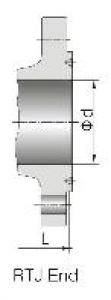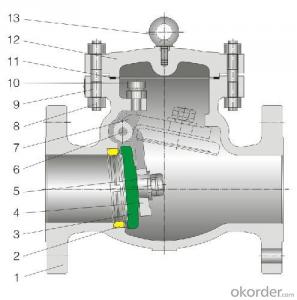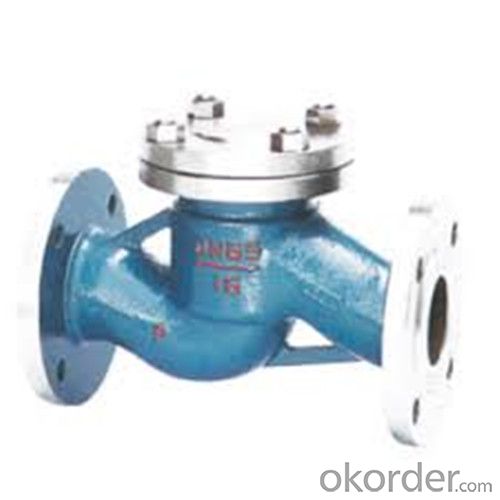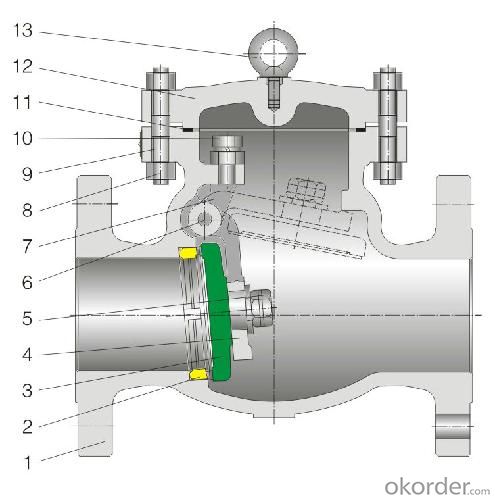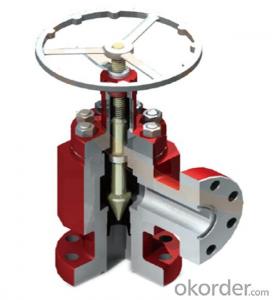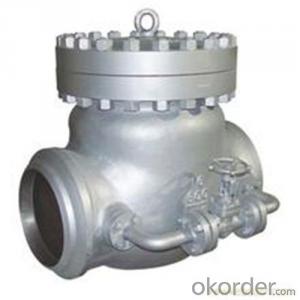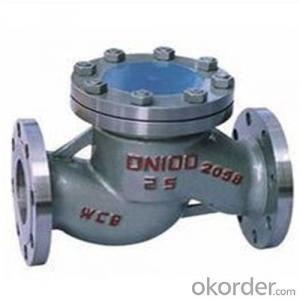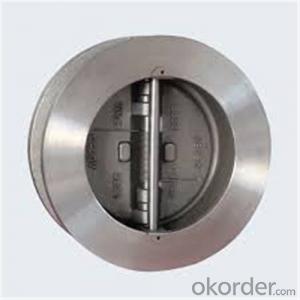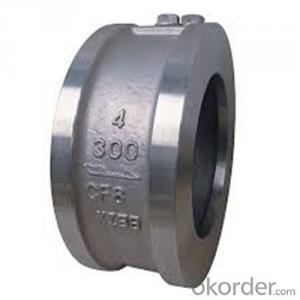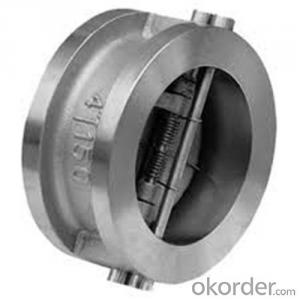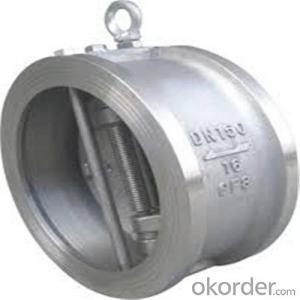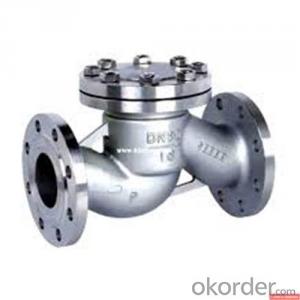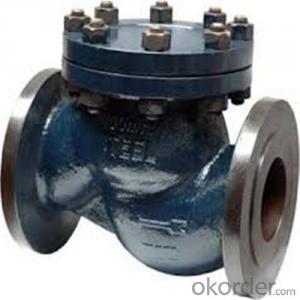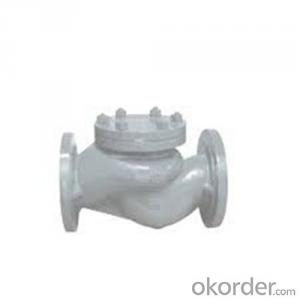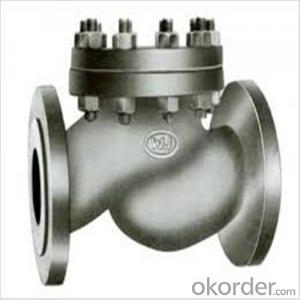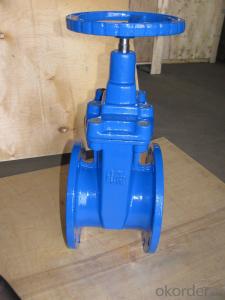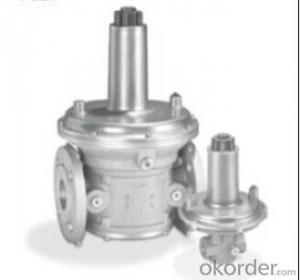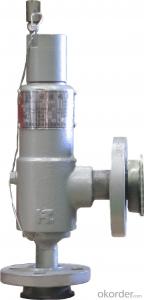API Cast Steel Lift Check Valve 300 Class
- Loading Port:
- Shanghai
- Payment Terms:
- TT OR LC
- Min Order Qty:
- 10 pc
- Supply Capability:
- 100 pc/month
OKorder Service Pledge
OKorder Financial Service
You Might Also Like
API Cast Steel Lift Check Valve 150 Class
The features of Cast Steel Lift Check Valve
Bolted Bonnet;Swing and lift disc;Metallic seating surfaces.
Body and Bonnet Connection of Cast Steel Lift Check Valve:
The body and bonnet of Class150~Class900 check valves are usually with studs and nuts.And the body and bonnet of Class1500~Class2500 check valves are usually of pressurized seal design.
Body-To-Bonnet Joint of Cast Steel Lift Check Valve:
Stainless steel + flesible graphite wounded gasket is used for Class 150 and Class 300 check valve;Stainless steel + flexible graphite wounded gasket is used for Class 600 check valve,and joint gasket is also optional for Class 600 check valve;Ring joint gasket is used for Class900 check valve;Pressurized seal design is used for Class 1500~Class 2500 check valves.
Seat of Cast Steel Lift Check Valve:
For carbon steel check valve,the seat is usually forged steel.The sealing surface of the seat is spray welded with hard alloy specified by the customer.Renewable threaded seat is used for NPS<10 check="" valves="" and="" welded="" on="" seat="" can="" be="" also="" optional="" if="" being="" requested="" by="" the="" customer.welded="" is="" used="" for="" nps="">12 crbon steel gate valves .Forstainless steel check valve,integral seat is usually adopted ,or to weld hard alloy directly integrally.Threaded or welded on seat is also optional for stainless steel check valve if being requested by the customer.
Parameter of Cast Steel Check Valve:
Standard Criteria | ASME/ANSI/API customize |
Pressure Rating | 150 Class 300 Class 600 Class 900 Class 1500 Class 2500 Class customize |
Valve Size | 50 mm 65 mm 80 mm 100 mm 125 mm 150 mm 200 mm 250 mm 300 mm 350 mm 400 mm 450 mm 500 mm 600 mm 650 mm 700 mm 750 mm |
2 inch 2.5 inch 3 inch 4 inch 5 inch 6 inch 8 inch 10 inch 12 inch 14 inch 16 inch 18 inch 20 inch 24 inch 26 inch 28 inch 30 inch customize | |
Actuator | Automatic customize |
Connection | Butt Welding Flange RF Flange RTJ customize |
1-Body Material | A216 WCB A351-CF8 A351-CF8M customize |
2-Seat ring | A351-CF8 A351-CF8M A105+13Cr Tool Steel+A105 customize |
3-Disc | Tool Steel+A216 WCB A351-CF8M A351-CF8 A216 WCB+13Cr customize |
4-Arm | A351-CF8 A216 WCB A351-CF8M customize |
5-Nut | A194 8M A194-8 A194 2H customize |
6-Arm pin | A182-F6a A182-F316 A182-F304 customize |
7-Yoke | A351-CF8 A351-CF8M A216 WCB customize |
8-Bonnet nut | A194 8M A194-8 A194 2H customize |
9-Bonnet bolt | A193-B8 A193-B8M A193-B7 customize |
10-Bolt | A193-B7 A193-B8 A193-B8M customize |
11-Gasket | graphite+304 graphite+316 customize |
12-Bonnet | A216 WCB A351-CF8M A351-CF8 customize |
13-Eye bolt | A181 customize |
Design Standard | API 6D BS 1868 customize |
Connection Standard | API 605 ASME B 16.25-2007 ASME B 16.47A ASME B 16.47B ASME B 16.5 MSS SP-44 customize |
Test Standard | API 598 API 6D customize |
Face to Face | ASME B 16.10 customize |
Pressure-temperature ratings | ASME B 16.34-2004 customize |
Wall thickness dimension | API 600 BS 1868 |
FAQ of Cast Steel Check Valve:
Q1:I can’t find the type of steel check valve which I need. what can I do?
The chart above only lists out some common composition of steel check valve parts.We may provide other different parts material composition according to the customer's request or the actual valve working condition.
Q2:Which certification do your products pass?
Our products are in accordance with ISO 9001、ISO 14001、API 6A、API 6D、TS CE、API607/6FA/BS6755.
- Q: Full Bore ball vale and Reduce bore ball valve have diferent with each other ,I want to know about them.
- These okorder
- Q: For instance, I am buying some new tires that don't have the valve stems on them, so could I remove my existing valve stems from my used tires onto the new tires? Is this recommend at all? Is it safe? Is it possible? Can this be done? why or why not? thank you.
- valve stems are part of the rim only, they cost only 1.50 at the parts store and a tire/service place will charge you 5 dollars on each or include them with the price of mounting and balancing. new ones are suggested always when you mount another tire
- Q: hi My Dad is 65 yrs old. he is very fit and healthy. He has had heart problems as long as i remmember! he has been under care for almost 2 years now and he has had to stents put in. Now the doctor has found out that his Mitral valve is leaking. They have told him tat he needs surgery to either have the valve replaced or repaired. i like to know if anyone out there has been through this and can help ease this a little as Ia really worried!! Thank you!
- Mitral valve surgery is surgery to either repair or replace the mitral valve in your heart. Minimally invasive mitral valve surgery is done through much smaller incisions (cuts). In open surgery, the surgeon makes a large incision (cut) in your breastbone to reach the heart. Mechanical heart valves do not fail often. However, blood clots develop on them. If a blood clot forms, you may have a stroke. Bleeding can occur, but this is rare. Biological valves tend to fail over time. But they have a lower risk of blood clots.
- Q: I am replacing the Camshaft, lifters, and timing chain on a SBC 350. The motor is still in the car and I have the valve covers and manifold removed (and other components). The camshaft break-in procedure recommends removing the inner valve springs and running engine at 2000-2500 rpm for 20-30 minutes. MY QUESTION: I have the valve spring compressor tool to remove the springs. HOW do I prevent the valve from falling into the cylinder when I remove the spring? Can I conduct the break in without removing the inner valve springs?
- What replaced into the reason they replaced the lifters? i believe those lifters are placed over the valve and spring assembly. because of the fact the cam lobe rides over the lifter face, the lifter will then act promptly on the valve and spring combination. If there replaced into an argument of wrong setting up, it could have manifested itself the minute the engine replaced into started. because of the fact it got here approximately some era after, it type of feels that there could have been underlying difficulty at artwork. Ruling out an oversped engine, another aspects could contain a valve keeper that had failed and allowed the valve to fall into the cylinder and hit the piston and reason substantial harm or a valve spring that breaks and motives the comparable factor. i know that this finished situation seems fairly coincedental, yet on occasion those issues take place and it in simple terms stinks.
- Q: Carbon keeps building up in the EGR valve. WHY?? and HOW DO I PREVENT IT? The engine is in PERFECT shape otherwise.
- First off, don't spend any money on this problem. I can't believe people are recommending you replace things like the fuel filter, pressure regulator, etc. Then again, I can, this is why I can find all those brand new parts in the wrecking yard...people spend as much money as they have guessing at the problem, and when they run out of money and its still not fixed, scrap the vehicle, new parts and all. Easiest and first thing to do is check the fuel pump fuse.
- Q: A friend of mine who is 26, was just told by her doctor that she has aenlarged heart valve. Is this really serious? Will she need surgery? Why can't I find any info on the internet? Please help I'm really worried. Thanks
- there are two valves in the heart, a bicuspid valve (two flaps) and a tricuspid valve (three flaps). A valve serves to prevent the back flow of blood in the heart, keeps it all flowing in one direction. An enlarged or incompetent valve would obviously be unable to do it's work properly. How serious the issue is depends entirely on the extent of enlargement. Enlargement is usually a result of uncontrolled blood pressure issues, but can also be genetic. As she is seeing a doctor about this, suggest that you let the doctor worry about it.
- Q: 12 valve
- Un plug the vacuum hose on top of the valve, loosen and remove the big tube nut on the bottom of the valve, I have found if you hit it sharply with a hammer 3 or 4 times before you try to loosen it won't break the valve off, once the tube nut is undone remove the 2 bolts holding the EGR valve to the intake manifold. Remove and discard the gasket and install the new valve in the reverse order. If the tube nut still won't come loose try heating it with a torch, if it's really rusted on you might have to replace the EGR tub along with the valve.
- Q: Hi all, I found oil leakage in my distributor and am about to change the o rings. however, i feel that a blocked PCV valve is causing the pressure to push oil into the distributor. I have been searching for the PCV valve. Can someone please tell me where it is?
- The PCV valve is located beneath the intake manifold on the right (passenger) side. It threads into the breather seperator and points toward the center of the car. To remove it, you'll have to remove the Idle Air Control valve located on the end of the manifold log. Be aware that you'll have to do at least part of this task underneath the car, and that the IAC valve has antifreeze circulating through it Get a mechanic to do it if you can afford it
- Q: Hi, I was told by my gardener that I need new sprinkler valves and each of those run about $50-70. I looked up online and I found them for $20 or less. Also what is the basic labor cost for getting them installed? I got estimates that range from $300-1000. I am confused.
- If it is $50-$70 installed, that is a good price. Where I work, we get $125, and that is about the going rate in the north east. If you want to do it yourself, do not use Toro valves, Toro is garbage. Hunter, Rainbird, Irritrol, and Weathermatic are all good valves. Dig a nice big hole where the valves are, longer on the downstream side of the sprinklers. Cut the line coming out of the valve, and unscrew it. If it is a tight fit, take the valve apart and unscrew it. If you have to take the new valve apart to put it on, There are only 3 parts inside, so don't worry about not being able to put it back together. From top to bottom, they are the spring, the rubber diaphram and the plastic ring. Then reconnect the lines coming out of the valve. Then connect the wires from the solenoid. 1 wire from each valve gets connected to the common wire. Look in your timer to see what color it is. Then the other wire gets connected to individual wires. Check the order of the wires to the valves. Write it down. This will help keep the valves in the same order they are in now. The prices you got 50-70 is what your gardener told you for each (i am assuming that he is installing them.) The 300-1000 just estimates for installation from different contractors. Unless you have 8 valves or more, the $1000 sound real high. You do not have to be a plumber to install the valves.
- Q: I need to replace my egr valve on my 98 Ford Taurus station wagon, and was wondering where is it located and how tough is it to replace?
- And use the engine treatment called Sea Foam. Your throttle body is full of crud from the egr, it gums up the inside of the throttle body and will lead to gummed up egr valve which it has. Best to give a good clean out while you are at it. You can return your egr valve if you have the receipt. With all this info you should be good to go., Hope it helps.
Send your message to us
API Cast Steel Lift Check Valve 300 Class
- Loading Port:
- Shanghai
- Payment Terms:
- TT OR LC
- Min Order Qty:
- 10 pc
- Supply Capability:
- 100 pc/month
OKorder Service Pledge
OKorder Financial Service
Similar products
Hot products
Hot Searches
Related keywords

